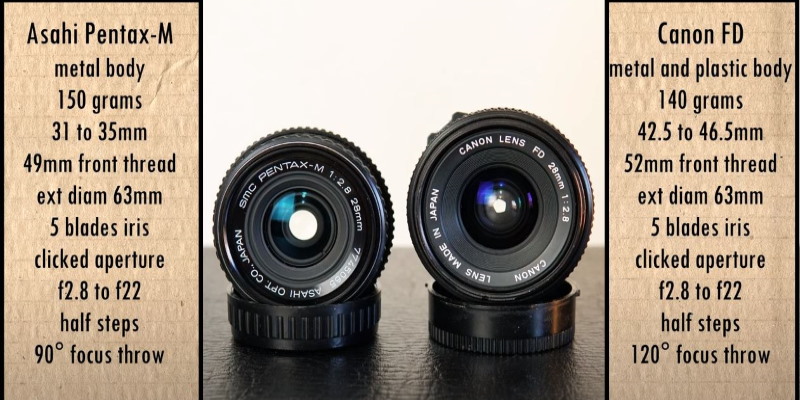
Canon FD 28mm f2.8 Vs SMC Pentax-M 28mm F2.8 Vintage Lens Sharpness Comparison Video.
In the world of vintage photography equipment, lenses stand as the vanguard of image quality, and as with any other category, enthusiasts and professionals have their favorites. Two classic 28mm lenses from the late 20th century — the Canon FD 28mm f2.8 and the SMC Pentax-M 28mm F2.8 — are among those often debated in photography circles. Both are representatives of their brands’ long-standing commitment to quality and innovation. Let’s dive deep into the characteristics, performance, and user experience of these two lenses.
Historical Context
Canon FD 28mm f2.8: Introduced as part of the FD lineup in the 1970s, this lens is compatible with Canon’s manual focus FD-mount cameras, like the Canon A-1 and Canon AE-1. It was designed to deliver a moderately wide-angle field of view, especially suited for landscapes and general photography.
SMC Pentax-M 28mm F2.8: This lens was introduced as part of the Pentax-M series, designed for K-mount SLR cameras. It followed the original K-series and was introduced to provide a more compact alternative. Like the Canon counterpart, it offers a moderately wide-angle perspective.
Design and Build Quality
Canon FD 28mm f2.8: The Canon lens bears the classic Canon FD design, with a solid metal barrel and a tactile rubber focus ring. Its aperture ring is clicky and precise. The FD lenses are known for their robust build, and this 28mm lens is no exception.
SMC Pentax-M 28mm F2.8: Pentax lenses from this era are revered for their build quality. The Pentax-M 28mm, being a part of the compact series, is noticeably smaller and lighter than many of its peers. However, it still boasts a full metal construction and feels solid in the hand. The focus ring, ribbed for better grip, offers a smooth rotation.
Optical Performance
Canon FD 28mm f2.8: This lens provides sharp images, especially when stopped down to f5.6 or f8. Chromatic aberration is generally well controlled. Flare resistance, while good for its time, might not match modern multi-coated standards, but some photographers appreciate this for its vintage feel. Bokeh, though not the primary reason for purchasing a wide-angle lens, is pleasant for the few instances where it’s achievable.
SMC Pentax-M 28mm F2.8: The SMC in the name stands for Super Multi-Coated – Pentax’s renowned lens coating process that enhances light transmission and reduces flare. Images produced by this lens are sharp, with particularly impressive center sharpness. Color rendition is vibrant, and contrast is typically ‘Pentax-like’ — punchy and pleasing. As with the Canon, bokeh is smooth when achievable, but not its main strength.
Usability
Both lenses are manual focus, which demands a learning curve for those accustomed to autofocus.
Canon FD 28mm f2.8: The focus ring is broad, and the throw is moderately long, making precise focusing relatively easy. The aperture ring is adjacent to the camera body when mounted, allowing for quick changes.
SMC Pentax-M 28mm F2.8: Given its compact size, the lens handles well on smaller SLRs and even on modern mirrorless cameras with adapters. The focus ring, while narrower than the Canon’s, is still adequately sized for precise focus.
Availability and Price
As vintage lenses, both the Canon and the Pentax are available on the second-hand market. Prices vary depending on condition and location. Generally, FD lenses tend to be more affordable than their contemporary counterparts, due to the vast number produced. The Pentax, being a sought-after brand among vintage lens enthusiasts, might command a slightly higher price, especially in excellent condition.
The Rap-Up
Both the Canon FD 28mm f2.8 and the SMC Pentax-M 28mm F2.8 are gems from a bygone era of photography. They capture the spirit of their times, emphasizing manual control, optical quality, and mechanical precision.
The Canon offers a robust, traditional design with reliable performance, while the Pentax stands out for its compactness and the unique color rendition and contrast its lenses are celebrated for.
In the end, choosing between them comes down to personal preference, the system one is invested in, and the specific requirements of the photographer. Regardless of the choice, both lenses are capable of creating memorable, high-quality images that carry a touch of vintage charm.
Thanks to Marco Aries for making the great video.